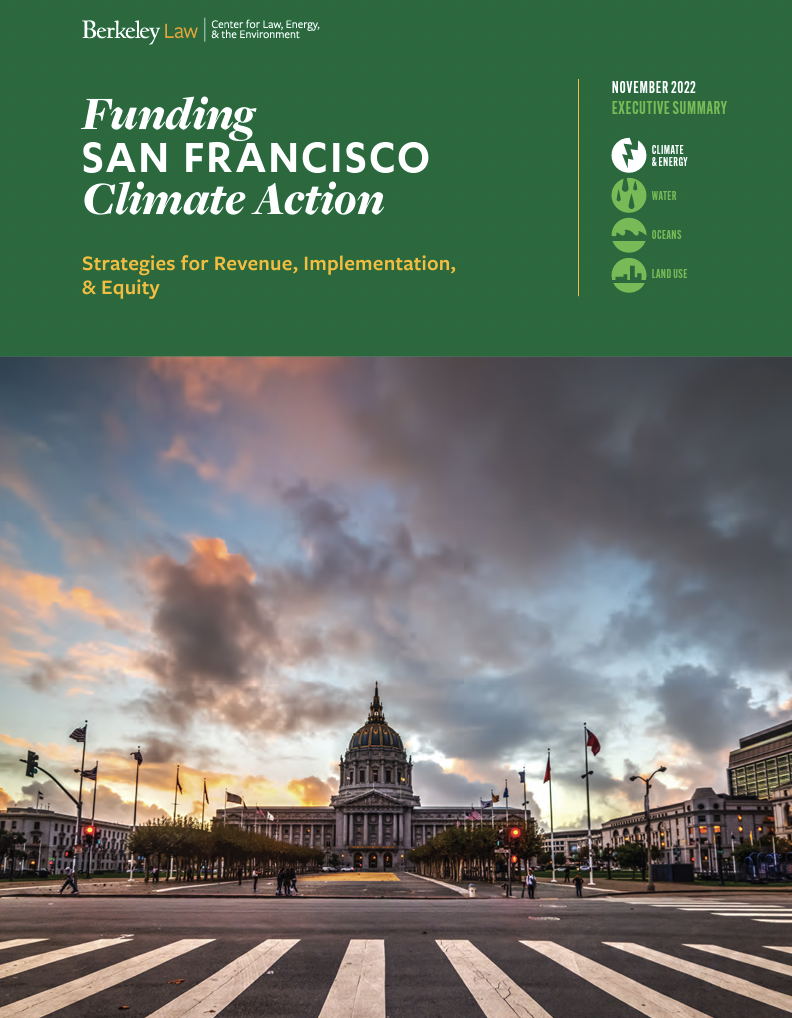Realizing Equitable Outcomes in Climate Action Plan Implementation
 As my colleagues Katie Segal, Ted Lamm, and Ross Zelen have described, our team at CLEE released an analysis earlier this month detailing how San Francisco can fund implementation of its Climate Action Plan. Katie provided an overview of the city’s Climate Action Plan (CAP), describing how San Francisco will need to secure tens of billions of dollars over the coming decades to deploy the emissions reduction strategy set forth in the CAP. Ted’s post explained how a city can use bonds, taxes, fees, or other mechanisms to raise municipal revenue for investments in decarbonization. Ross’s post outlined funding opportunities in the recent federal climate laws, the Inflation Reduction Act and the Infrastructure Investment and Jobs Act.
As my colleagues Katie Segal, Ted Lamm, and Ross Zelen have described, our team at CLEE released an analysis earlier this month detailing how San Francisco can fund implementation of its Climate Action Plan. Katie provided an overview of the city’s Climate Action Plan (CAP), describing how San Francisco will need to secure tens of billions of dollars over the coming decades to deploy the emissions reduction strategy set forth in the CAP. Ted’s post explained how a city can use bonds, taxes, fees, or other mechanisms to raise municipal revenue for investments in decarbonization. Ross’s post outlined funding opportunities in the recent federal climate laws, the Inflation Reduction Act and the Infrastructure Investment and Jobs Act.
Meeting international climate targets will require successful funding and implementation of climate action plans by cities, states, and businesses. Embedding and prioritizing equity principles throughout the process of implementing local climate actions is also critically important to drive the transition to a low-carbon economy. San Francisco developed its CAP with racial and social equity as central pillars because racial and ethnic inequity are the drivers of health inequities in the city, and our report highlights a set of strategies to advance equity through the CAP.
Advancing Racial and Social Equity Through CAP Implementation
Advancing racial and social equity through the CAP requires that leaders pay equal attention to the process of implementation (and the sources of revenue) as to the actions themselves. Our analysis of funding options includes a set of implementation and equity measures to accompany investment and support equitable outcomes. These recommendations include identifying and working with priority populations, engaging and realizing community leadership, and supporting community-led investment at each stage of CAP implementation.
Identify and Work with Priority Populations
The CAP includes an Environmental Justice Communities Map for the City of San Francisco. The City’s map combines information from CalEnviroScreen, the State of California’s tool to identify disadvantaged communities with local pollution and demographic data. By using local data alongside CalEnviroScreen, the City’s EJ Map is more reflective of local conditions and can better inform implementation. While CalEnviroScreen and the Biden Administration’s Climate and Economic Justice Screening Tool offer fantastic baseline analyses, it will be vital for local governments to develop tailored maps as they begin to invest via their CAPs.
Using this map to guide CAP implementation, outreach, and investment will be critical for ensuring that the most impacted communities benefit from the plan. Specifically, the City should use the tool to help identify which communities are highest priority for near-term investment of public funds, and then work with these communities to identify and develop investments that meet community priorities and achieve emission reductions. The CAP also included a Racial and Social Equity Assessment Tool to evaluate the equity outcomes and implications of CAP strategies. As we discuss in our analysis, San Francisco and other cities should engage in this type of analysis at multiple stages of the CAP process to inform initial investment choices and ongoing decision-making.
Engage and Realize Community Leadership
The City conducted broad community engagement as it developed the CAP and advanced this engagement through CLEE’s research process and ongoing funding discussions. As it moves to implementation, the City needs to formalize processes for continued, meaningful engagement. This includes establishing a community council, with real decision-making authority, to provide oversight of investments and using tools like participatory budgeting to reflect community priorities in investment choices. San Francisco’s Municipal Transportation Agency employed a participatory budgeting process in its Bayview Community Based Transportation Plan, which reflects community priorities for investment of a limited set of funds. New York, Fresno, and other cities around the country offer other valuable examples of how participatory budgeting can inform a portion of CAP investments. San Francisco must provide sustained resources, including staffing and budgets, to provide long-term support for community engagement and capacity building.
Support Community-Led Investment Programs
Realizing community transformation and equitable outcomes requires space for community-driven and community-led investments that reflect local priorities and vision. The State of California’s Transformative Climate Communities (TCC) program provides a model for neighborhood-scale investment in communities disproportionately burdened by pollution and with high concentrations of poverty. TCC projects have incorporated a mix of community planning, participatory budgeting, oversight, and other strategies to bring state climate funds to the most locally appropriate and desired investments. Evaluations of these investments show the positive outcomes not just from the physical infrastructure investments, but also the social and economic benefits of these projects. Given the transformative, multi-decade investment programs that CAPs envision, it will be vital for cities to engage communities and build TCC-style initiatives directly into CAP implementation.
Through a comprehensive approach to equity in CAP revenue and implementation, the City of San Francisco can provide a model for how local governments can create similar opportunities for local communities.







Reader Comments